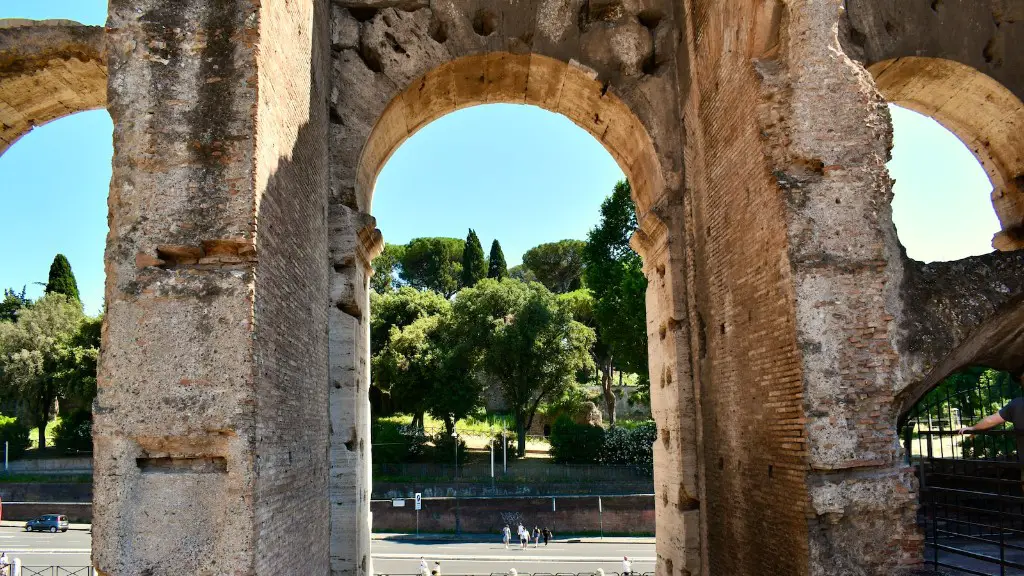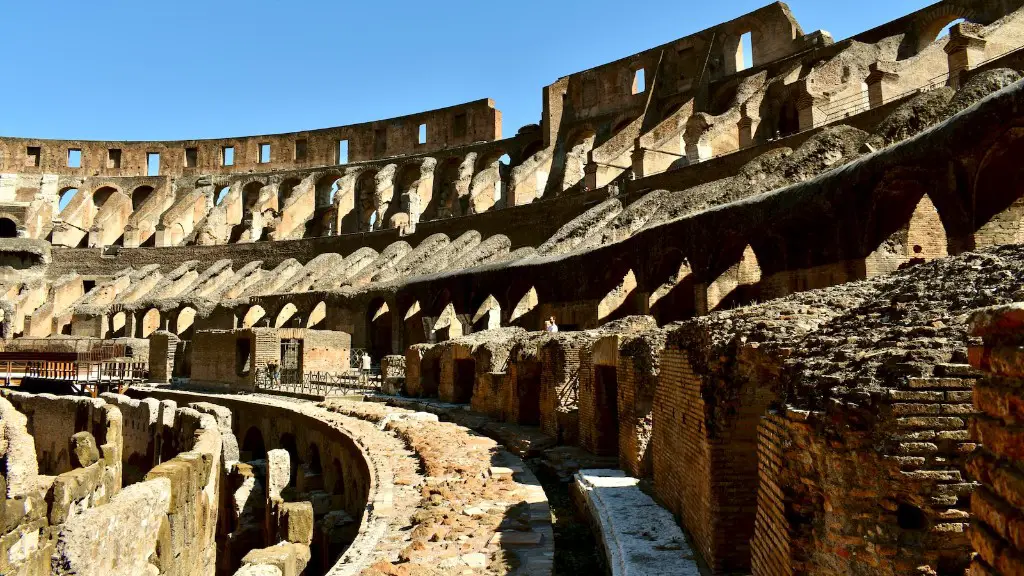Ancient Rome was located in the central-western region of the Italian peninsula, which is now known as Lazio. It was a crossroads between the Mediterranean and Europe, as well as the gateway to the sea for the lands of the Italian peninsula. Practically speaking, it was a medium-sized region surrounded by several mountains that provided natural protection from enemies. As the center of the Roman Empire, it was the political, economic and military hub of the ancient Western world.
The Romans managed the land they conquered in the peninsula with great effectiveness and power. This allowed them to greatly expand their domain over time. They created an interconnected network of roads which connected the city of Rome to their territories, and provided them with easy access to both the Mediterranean Sea and the rest of Europe. With the growth of its domain, Rome was able to build monumental structures such as the Colosseum, the Pantheon, and the Roman Forum.
The law and order that was established in Rome was also one of the main factors that led to its growth. The Senate and the Roman assemblies could appoint magistrates and issue laws. Furthermore, the legal system of Rome provided significant protection to the people and their property and that is why it was admired by other cultures during this time.
Ancient Rome was a multi-ethnic and multi-cultural society which served as a major example of the benefits of living in a unified state. Its inhabitants included people from all over the Mediterranean, even though Roman citizens would hold most of the power. By embracing trade and other civilisations, Rome became one of the greatest empires in human history.
Roman Military Might
Roman military strength was another one of the main aspects of the ancient Roman Empire, which ultimately brought great success. Its military was a combination of professional soldiers from Rome and from allied countries, which was extremely effective in their conquests. This was especially true during their advance into the far reaches of Europe and the Mediterranean, constantly strengthening their empire. Rome extensively employed use of siege weapons, such as catapults, to bring down its enemies with ease.
Over time, the Romans improved the design of their military equipment, which made them even more powerful. One example of this is the iconic gladius, which was a short sword that was used by the legions during close-quarters combat. Their siege towers, rams, and battering rams also proved to be extremely effective in taking down their enemies’ walls and provided them with greater success in battle.
The Roman army was also known for its unique and effective battle formations, based upon both intelligence and strength. The legions were divided into smaller units of around 5,000 soldiers each and were usually armed with different weapons in order to maximise efficiency and effectiveness. In addition, military campaigns were carefully planned out in order to ensure maximum victory.
The feats of Roman engineering and military might have contributed to the greatness of this culture, later remembered by the world. Their ideas and methods were adopted and assimilated by the great civilizations that followed. These innovations would contribute in making the region of Italy a great political and economic power in the centuries to come.
Roman Society
One of the main reasons Rome was so successful was due to its extensive legal system. This was a matter of great importance as it allowed the deployment of services like taxation, which was essential for their military victories. Furthermore, the Senate was responsible for passing and enforcing laws in the city and they used checks and balances in order to ensure justice.
The Roman social hierarchy was organized into different classes, such as patricians, plebeians and slaves. This structure helped to ensure a stable and functioning society and was one of the main contributors to its success. The wealthy upper classes were in charge of the bureaucracy and stood in a privileged position in comparison to the masses. Slaves were treated as property and worked in farms, industries, and mines.
The religion and philosophy of the ancient Romans also played a key role in their success. They believed in a variety of gods and goddesses, which were often associated with different areas of life. Each culture, city and family had its own private deities, but the ones that ruled supreme over Rome were Jupiter, Mars, Juno and Minerva. This religious devotion helped to inspire and motivate Roman citizens.
The Romans also adopted some of the technologies and ideas of their conquered societies, enabling them to become the great power that they were. They adopted the Greek language and literature, as well as the Etruscan alphabet. They established a strong monetary system based on silver and gold coins and created paper money. Roman engineering and architecture was highly innovative and can still be seen in structures all around the world.
The cultural achievements of the ancient Romans are unrivaled, and their impact can still be seen today. It is no wonder why many consider them to be one of the most influential empires in human history.
Roman Law
The Roman law was one of the most important aspects of the Roman Empire, which provided citizens with rights, protected their property and formed the basis of the economic and political structure. It was divided into two branches, civil and criminal law, that were separated from each other and enforced by the magistrates.
The Romans were acutely aware of the importance of justice, and that is why the system of laws was constantly evolving. This is especially true for civil law. Roman jurists were in charge of creating laws adapted to changing times, in order to ensure that justice was applied and disputes were dealt with in a fair manner.
The law of Rome was largely based on the twelve tables, which formed the basis of private law and provided citizens with the protection of private property rights. Furthermore, the process of litigare allowed citizens to seek justice in the event of a legal dispute.
The Roman law was highly influential during this time, as it was adopted by other civilizations. This legal code was so powerful that some of the laws created during the Roman Empire are still in effect in modern day countries. This strength in the legal system ultimately allowed Rome to grow in size and power.
Roman Education
Education was of great importance for the Romans, which was not only seen in the quality and level of their technical and practical achievements, but also in their culture. Schools were established in order to teach the young about the law, literature, rhetoric, mathematics and the sciences.
Students were also taught skills such as weaving, farming and woodworking, as these trades were essential for a prosperous society. This was especially true for the upper classes, who would need such knowledge for their public life.
Aside from teaching, libraries were also established with the intention of preserving the ideas of their writers and thinkers. It should be noted that libraries were so important that they were some of the first places to be built in newly conquered territories.
The education system was also highly advanced for its time, with schools mainly organized around philosophy and rhetoric. This allowed brilliant minds to become proficient in numerous areas and provided the skills necessary for Romans to progress in engineering, literature, politics and business.
It should be noted that the Romans were great believers in knowledge, and that is why important figures such as Cicero and Plato were praised throughout their time. Through education, science and philosophy, Romans greatly contributed to the advancement of human civilization and to their own success.
Roman Religion
The Romans were polytheistic, believing in a variety of deities. Each one had its own distinct traits, so people would often choose one that was most appropriate to their situation. The gods and goddesses were part of everyday life and ceremony, providing a spiritual foundation for their culture.
The most important of the gods were Jupiter, Mars, Juno and Minerva. Jupiter was considered to be the king of the gods and was associated with thunder, law and power. Mars was the god of war and strife. Juno was the goddess of love and childbirth, while Minerva was the goddess of wisdom and knowledge.
Religions ceremonies were also important for the Romans, such as the use of sacrifices to appease the gods. Furthermore, temples and shrines were built to honor the gods, inviting pilgrims from all over the Mediterranean. It is said that the cult of the god Mithras was one of the most widespread among the Legions and was adopted during the time of Augustus.
The religion of the ancient Romans has had a great impact in the Western world, and it can still be seen in the symbols, traditions and ideas of today. The influence of their gods and goddesses is so great that many of them have been adopted by past and present cultures, inspiring stories, art and literature.
Roman Architecture
The architecture of Ancient Rome is known for its grandiose and innovative structures, which have stood the test of time. National monuments were constructed with the intention of expressing the power and greatness of Rome, such as the Colosseum, Pantheon and the Roman Forum. These structures still serve as an inspiration for modern architects.
The Colosseum is a perfect example of Roman architecture, which served as a prototype for many of the sports stadiums that are present in the world today. Its impressive columns, arches and vaults characterize its grandiosity, while the interior of the building was designed for maximum seating space. The structure was also connected to other great structures such as the Roman Forum and the Circus Maximus.
The Pantheon is another great structure created by the Romans. Constructed by Emperor Hadrian, this temple was dedicated to all gods of the pagan pantheon. The dome, which is the most recognizable part of the Pantheon, stands over the other eight sections of the building in a state of perfect harmony. Its walls are decorated with bas-reliefs and sculptures, showing the skill and precision of the builders.
The Roman Forum was the heart of the city in ancient times and served as a public gathering place. Constructed with the intention of providing its citizens with entertainment, the Forum is comprised of several squares and plazas, with monuments, temples and other structures situated in its grounds. This was the political center of Rome, where important events such as elections and speeches took place.
The architecture of Ancient Rome is a reminder of the great achievements and power of this empire. One can still visit structures such as the Colosseum and the Pantheon in order to relive its grandeur, and it is without a doubt one of the most beautiful examples of architecture in the world.

